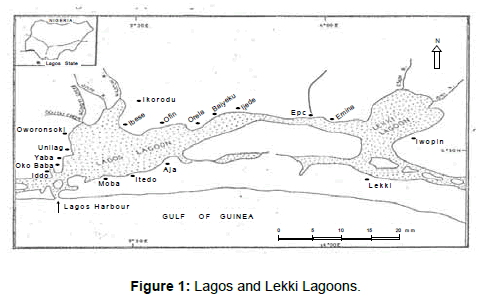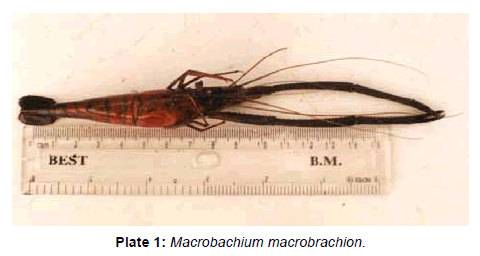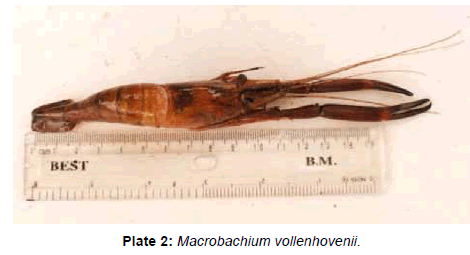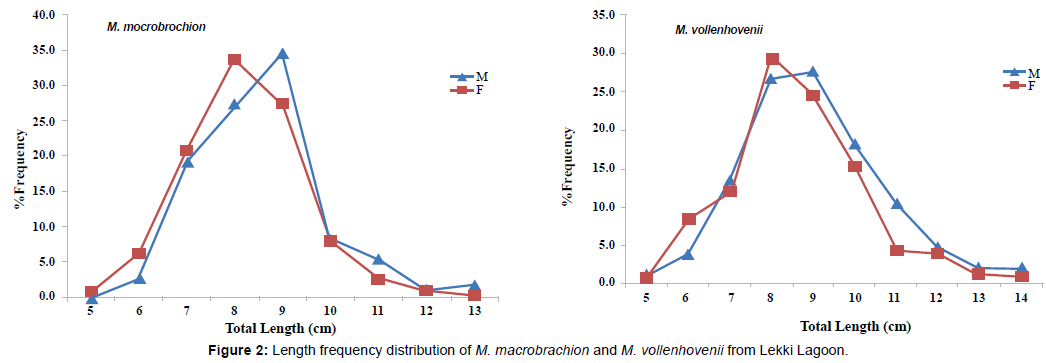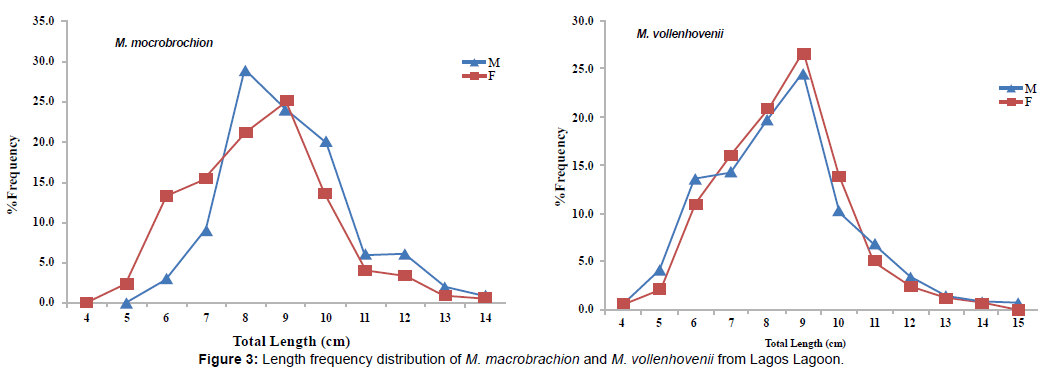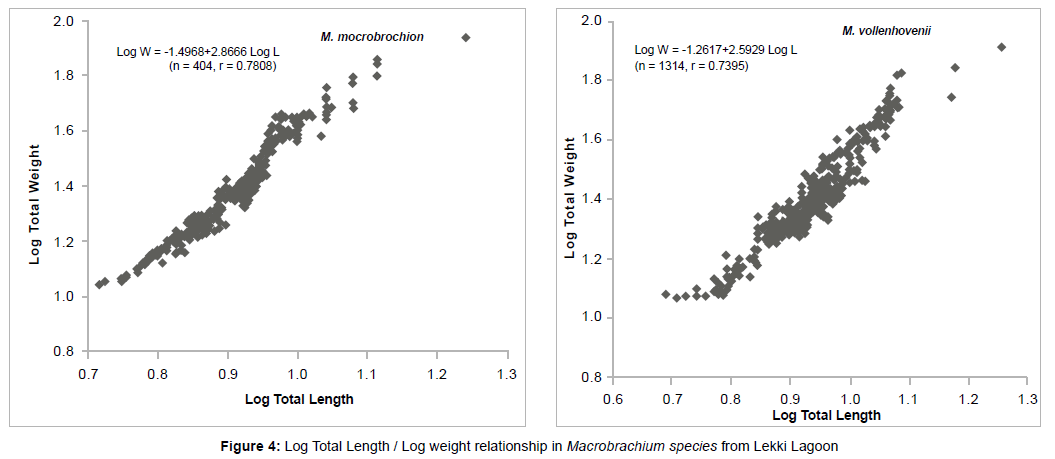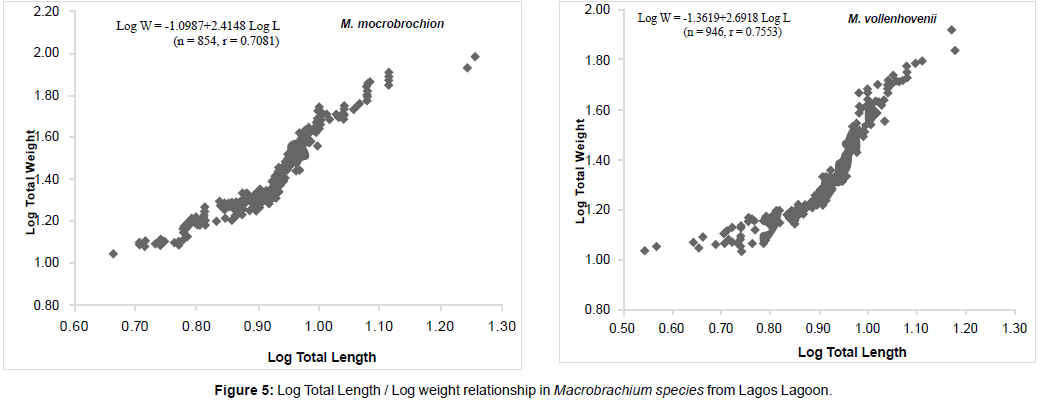Research Article Open Access
Comparative Biology of the Prawns Macrobrachium macrobrachion (Herklots) and Macrobrachium vollenhovenii (Herklots) From Two Interconnecting Fresh/Brackish Water Lagoons in South-West Nigeria
Aderonke Omolara Lawal-Are* and Aminat Temitope OwolabiDepartment of Marine Sciences, University of Lagos, Akoka, Lagos 234, Nigeria
- *Corresponding Author:
- Aderonke Omolara Lawal-Are
Department of Marine Sciences
University of Lagos, Akoka
Lagos 234, Nigeria
Tel: +2348033020969
E-mail: alawalare@unilag.edu.ng
Received date March 27, 2012; Accepted date May 21, 2012; Published date May 23, 2012
Citation: Lawal-Are AO, Owolabi AT (2012) Comparative Biology of the Prawns Macrobrachium macrobrachion (Herklots) and Macrobrachium vollenhovenii (Herklots) From Two Interconnecting Fresh/Brackish Water Lagoons in South- West Nigeria. J Marine Sci Res Dev 2:108. doi: 10.4172/2155-9910.1000108
Copyright: © 2012 Lawal-Are AO, et al. This is an open-access article distributed under the terms of the Creative Commons Attribution License, which permits unrestricted use, distribution, and reproduction in any medium, provided the original author and source are credited.
Visit for more related articles at Journal of Marine Science: Research & Development
Abstract
The prawns, Macrobrachium species belonging to the family Palaemonidae are decapod crustaceans of high economic importance world-wide and have been subjected to intense aquacultural practices
especially in Asia and the Americas. Macrobrachium rosenbergii is one of the best farmed species in this family. FAO (Food and Agriculture Organisation of the United Nations) gave details of its identification, profile, production, statistics, status and trends. Global production of M. rosenbergii has increased to over 200,000 tonnes/yr by 2002.
Macrobrachium species occur commonly in the West African region and constitute an important part of the artisanal fishery. Two species of these prawns Macrobrachium macrobrachion and M. vollenhovenii are important food items and are good items for exports when fully recruited for aquaculture.
Introduction
The prawns, Macrobrachium species belonging to the family Palaemonidae are decapod crustaceans of high economic importance world-wide and have been subjected to intense aquacultural practices especially in Asia and the Americas. Macrobrachium rosenbergii is one of the best farmed species in this family. FAO (Food and Agriculture Organisation of the United Nations) [1] gave details of its identification, profile, production, statistics, status and trends. Global production of M. rosenbergii has increased to over 200,000 tonnes/yr by 2002.
Macrobrachium species occur commonly in the West African region and constitute an important part of the artisanal fishery. Two species of these prawns Macrobrachium macrobrachion and M. vollenhovenii are important food items and are good items for exports when fully recruited for aquaculture [2,3].
Despite its economic importance and future potentials very little documented works are available on these prawns in West Africa. Aspects of the biology of the Macrobrachium species occurring in Nigeria have been documented by Marioghae [4] on the ecology and distribution in Lagos Lagoon, Powell [5] on their occurrence in the Niger Delta area, Anetekhai [6,7] on the salinity tolerance and sexual dimorphism in Asejire Lake, Bello-Olusoji et al. [8] on the food of the larvae, Jimoh et al. [9] on the food and feeding habits in Epe Lagoon and Abohweyere [10] on the recruitment pattern in the Lagos-Lekki Lagoon system.
Macrobrachium species live in freshwater and low salinity waters not exceeding 100/00, but their larval stages require brackish water conditions for their survival and optimum development [5,11].
M. macrobrachion and M. vollenhovenii occur in the interconnecting Lagos and Lekki Lagoons where they support an artisanal fishery carried out mostly by women. The Lagos Lagoon with a surface area of nearly 208 km2 is brackish with salinity range of 0.050/00 – 28.70/00 while the Lekki Lagoon with surface area of about 247 km2 is mostly freshwater with salinity range of 0.0 – 3.10/00 [12-15].
While prawn farming is well developed in Asian countries and America [16-18], proposals are just now on hand to culture them in the West African region. Until adequate hatchery systems are developed for production of their seeds, the young prawns may still have to be sourced from the wild. With the heavy population of M. macrobrachion and M. vollenhovenii in the Lagos and Lekki Lagoons, the two lagoons will constitute ready sources of these prawns in south-west Nigeria.
This paper provides information on a comparative study of the biology of M. macrobrachion and M. vollenhovenii in the two interconnecting but environmentally different Lagos and Lekki Lagoons with particular emphasis on the size composition, growth pattern, food habits and reproductive biology. The FAO [12] suggested the opening up of Lekki Lagoon by dredging a channel directly to the adjacent Atlantic Ocean in order to decongest the overcrowded Lagos harbour. The Nigerian government has now decided to build the harbour at Iwopin on the shore of Lekki Lagoon. This will definitely cause a major increase in salinity of Lekki Lagoon. This study will therefore form a documentation of the biology of the Macrobrachium species in the lagoon prior to any ecological changes in the ecosystem.
Materials and Methods
Study area
This study was carried out in Lagos and Lekki Lagoons in southwest Nigeria. Lagos Lagoon is located between latitudes 6º 26′ and 6º 39′N and longitudes 3º 29′ and 3º 50′E (Figure 1). It forms part of an intricate system of waterways made up of lagoons and creeks that are found along the coast of Nigeria from the border of the Republic of Benin to the Niger Delta. The Lagos Lagoon has a surface area of about 208 km2. Some of the physico-chemical parameters have been documented by Adetayo and Kusemiju [19]. The substratum is fine sand and mixed mud. Lekki Lagoon lies between latitudes 6º 25′ and 6º 37′N and longitude 4º 00′ and 4º 15′E (Figure 1). It has a surface area of about 247 km2 and is fed by Rivers Oni and Osun. Both Lagos and Lekki Lagoons empty into the Atlantic Ocean via the Lagos Harbour. The hydrobiology and fishes of the Lekki Lagoon have been documented by Kusemiju [14].
Collection of samples
This study was carried out during the rainy season (August to October, 2008) and dry season (January to March, 2009) in Lagos and Lekki Lagoons. Bimonthly samples of M. macrobrachium and M. vollenhovenii were collected in the lagoons from fisher folks. The fishing was done with cone-shaped bamboo basket traps described by Solarin et al. [20] and Jimoh et al. [9]. The basket trap had a two nonreturn valve mechanism at the centre of the trap. It had a total length and opening aperture of about 1.0 m and 0.3 m respectively. Coconut and fresh palm oil fruits were used as baits for the prawns. Selection of prawns was done randomly as they were harvested from the basket traps. The prawns were immediately preserved in an ice-chest with ice-blocks and later transferred into the deep freezer (-20°C) in the laboratory prior to analysis.
Laboratory analysis
Identification: The prawns were identified using morphological characters reported by Holthius [21] and Powell [5]. Both M. macrobrachion and M. vollenhovenii were recognisable by their large second cheliped which usually end in strong pincers. While the chelipeds are stout and singular in M. vollenhovenii, they are slender and the pincer furry in M. macrobrachion.
Sex was determined using morphometric features, such as presence of an appendix masculina on the second pleopods and an appendix interna in the male while only the appendix interna was present in the female. There is also a lump on the ventral view of the first segment of the male abdominal region which could be felt by the tip of finger while it was absent in the female [7,10].
The Total Length (TL) was measured to the nearest 0.1 cm from the orbital notch to the tip of the telson using a Vernier caliper [21,22]. The total weight was obtained by use of a sensitive Sartorius top loading balance (Model 1106) to the nearest tenth of a gram.
Growth pattern: For a comparison of the growth biology of the prawns, the length /weight relationship was expressed as [23]:
Log W = Log a + b Log L (1)
where W = weight of prawn in g, L = total length in cm, a = regression constant and b = regression coefficient.
The condition factor (K) of the prawns was determined using the formula [24]:
 (2)
(2)
where W = weight of prawns in g, L = total length in cm, b = regression coefficient.
Food analysis: For the food study, the stomach contents were examined. For each specimen, the stomach contents were dissected out and the contents examined under an Olympus binocular microscope. The food analysis was by the numerical and occurrence methods [25,26].
Fecundity estimate: The eggs were weighted and preserved in 4% formalin prior to counting. The total number of eggs was estimated using the gravimetric method. For a given batch of eggs, the total weight was found to 0.001g accuracy. Adapting the method described by Anetekhai, Bagenal and Ofori-Danson [26-28], a random sample from a given batch of eggs was weighed and the eggs in the sample counted. The number obtained was raised by the ratio: total weight / weight of sample, to get the total number of eggs.
Sex ratio:
The chi- square test was performed for the sex ratio of the prawns:
 (3)
(3)
Where fi -= observed frequency and Fi = expected frequency.1
Results
Size composition
3498 specimens made up of 1258 M. macrobrachion (Plate 1) and 2240 M. vollenhovenii (Plate 2) were examined in this study. 2298 (65.7%) of the specimens were collected during the rainy season (August – October, 2008) while 1200 (34.3%) specimens were obtained in the dry season (January – March, 2009). The pattern of occurrence of the prawns is shown in Tables 1 and 2.
| Species | Rainy Season | Dry Season | ||
| Male | Female | Male | Female | |
| M. macrobrachion | 90 | 230 | 34 | 50 |
| M. vollenhovenii | 172 | 606 | 128 | 388 |
Table 1: Collection of Macrobrachium species from Lekki Lagoon during Rainy and Dry Seasons.
| Species | Rainy Season | Dry Season | ||
| Male | Female | Male | Female | |
| M. macrobrachion | 150 | 412 | 50 | 242 |
| M. vollenhovenii | 194 | 444 | 80 | 228 |
Table 2: Collection of Macrobrachium species from Lagos Lagoon during Rainy and Dry Seasons.
The length frequency distributions of the prawns from the two lagoons are shown in Figures 2 and 3. The prawn populations were made up of one year class. In Lekki Lagoon larger specimens of M. macrobrachion (total length 8.5 cm – 13.4 cm) and M. vollenhovenii (total length 7.9 cm – 14.3 cm) were obtained. In the Lagos Lagoon, the total length of larger specimen of M. macrobrachion ranged from 8.6 cm – 14.1 cm, while M. vollenhovenii ranged from 8.0 cm – 15.2 cm total length.
Growth pattern
Length/weight Relationship
M. macrobrachion in Lekki Lagoon ranged in total length from 4.9 cm to 13.4 cm and total weight from 8.3 g to 71.8 g, while M. vollenhonvenii in Lekki Lagoon ranged in total length from 4.5 cm to 14.1 cm and total weight from 6.9 g to 70.1 g.
M. macrobrachion from Lagos Lagoon ranged in total length from 4.6 cm to 14.1 cm and total weight 7.1 g to 69.7 g, while M. vollenhonvenii in Lagos Lagoon ranged in total length from 3.5cm to 15.2 cm and total weight from 10.9 g – 83.1 g. The Log length/Log weight relationships are shown in Figures 4 and 5. The calculated log of the length/weight relationship of the Macrobrachium sp showed a linear relationship between the length and weight of the prawns.
Condition factor
The condition factor which indicated the state or overall well-being of the prawns is given in Tables 3–6. The condition factors ranged between 2.12 and 7.98 in both lagoons. It was observed that there was no marked variation in the condition factor between the sexes but K-values decreased with increasing size of prawns in the two lagoons.
| Male | Female | Combined Sex | ||||||||||
| Tl (Range) | N | Tl | Wt | K | N | Tl | Wt | K | N | Tl | Wt | K |
| (cm) | (cm) | (g) | (cm) | (g) | (cm) | (g) | ||||||
| 4.5 – 5.4 | - | - | - | - | 2 | 5.3 | 11.2 | 7.52 | 2 | 5.3 | 11.2 | 7.52 |
| 5.5 – 6.4 | 3 | 6.2 | 13.5 | 5.66 | 13 | 6.1 | 13.5 | 5.95 | 16 | 6.2 | 13.5 | 5.80 |
| 6.5 – 7.4 | 25 | 7.0 | 15.9 | 4.64 | 86 | 7.0 | 17.7 | 5.16 | 111 | 7.0 | 16.8 | 4.90 |
| 7.5 – 8.4 | 33 | 8.0 | 22.2 | 4.34 | 90 | 8.0 | 22.2 | 4.34 | 123 | 8.0 | 22.2 | 4.34 |
| 8.5 – 9.4 | 43 | 8.9 | 29.4 | 4.17 | 52 | 8.8 | 29.2 | 4.28 | 95 | 8.9 | 29.3 | 4.23 |
| 9.5 – 10.4 | 8 | 9.9 | 38.0 | 3.92 | 21 | 9.8 | 38.6 | 4.10 | 29 | 9.9 | 38.3 | 4.01 |
| 10.5 – 11.4 | 7 | 11.0 | 51.2 | 3.85 | 8 | 10.9 | 46.4 | 3.58 | 15 | 11.0 | 48.8 | 3.72 |
| 11.5 – 12.4 | 3 | 12.0 | 62.0 | 3.59 | 6 | 12.0 | 52.3 | 3.03 | 9 | 12.0 | 57.2 | 3.31 |
| 12.5 – 13.4 | 2 | 13.3 | 70.6 | 3.00 | 2 | 13.0 | 63.0 | 2.87 | 4 | 13.2 | 66.8 | 2.94 |
| 124 | 280 | 404 | ||||||||||
Table 3: Condition factor (K) by sex of M. macrobrachion from Lekki Lagoon.
| Male | Female | Combined Sex | ||||||||||
| Tl (Range) | N | Tl | Wt | K | N | Tl | Wt | K | N | Tl | Wt | K |
| (cm) | (cm) | (g) | (cm) | (g) | (cm) | (g) | ||||||
| 4.5 – 5.4 | - | - | - | - | 16 | 5.1 | 9.3 | 7.01 | 16 | 5.1 | 9.3 | 7.01 |
| 5.5 – 6.4 | 6 | 6.3 | 14.5 | 5.80 | 90 | 6.0 | 13.7 | 6.34 | 96 | 6.2 | 14.1 | 6.06 |
| 6.5 – 7.4 | 18 | 7.0 | 18.4 | 5.36 | 85 | 7.0 | 19.2 | 5.60 | 103 | 7.0 | 18.8 | 5.48 |
| 7.5 – 8.4 | 58 | 7.9 | 22.7 | 4.60 | 141 | 8.0 | 22.4 | 4.38 | 199 | 8.0 | 22.6 | 4.49 |
| 8.5 – 9.4 | 48 | 8.9 | 26.9 | 3.82 | 170 | 8.9 | 26.3 | 3.73 | 218 | 8.9 | 26.6 | 3.77 |
| 9.5 – 10.4 | 42 | 9.8 | 34.6 | 3.68 | 92 | 9.8 | 33.8 | 3.59 | 134 | 9.8 | 34.2 | 3.63 |
| 10.5 – 11.4 | 13 | 11.0 | 41.8 | 3.14 | 28 | 11.0 | 43.9 | 3.30 | 41 | 11.0 | 42.9 | 3.22 |
| 11.5 – 12.4 | 11 | 11.9 | 50.4 | 2.99 | 22 | 11.9 | 51.3 | 3.04 | 33 | 11.9 | 50.9 | 3.02 |
| 12.5 – 13.4 | 2 | 13.0 | 56.7 | 2.58 | 6 | 13.0 | 57.9 | 2.64 | 8 | 13.0 | 57.3 | 2.61 |
| 13.5 – 14.4 | 2 | 14.1 | 64.8 | 2.31 | 4 | 13.7 | 60.9 | 2.37 | 6 | 13.9 | 62.9 | 2.34 |
| 200 | 654 | 854 | ||||||||||
Table 4: Condition factor (K) by sex of M. macrobrachion from Lagos Lagoon.
| Male | Female | Combined Sex | ||||||||||
| Tl (Range) | N | Tl | Wt | K | N | Tl | Wt | K | N | Tl | Wt | K |
| (cm) | (cm) | (g) | (cm) | (g) | (cm) | (g) | ||||||
| 4.5 – 5.4 | 2 | 4.9 | 7.8 | 6.63 | 7 | 5.2 | 10.7 | 7.61 | 9 | 5.1 | 9.3 | 7.18 |
| 5.5 – 6.4 | 8 | 5.9 | 11.4 | 5.55 | 45 | 6.2 | 15.1 | 6.34 | 53 | 6.1 | 13.3 | 5.98 |
| 6.5 – 7.4 | 28 | 7.1 | 17.9 | 5.00 | 102 | 7.0 | 20.1 | 5.86 | 130 | 7.1 | 19.0 | 5.42 |
| 7.5 – 8.4 | 67 | 8.0 | 22.5 | 4.39 | 296 | 8.0 | 24.0 | 4.69 | 363 | 8.0 | 23.3 | 4.54 |
| 8.5 – 9.4 | 68 | 8.9 | 27.6 | 3.92 | 264 | 8.9 | 27.9 | 3.96 | 332 | 8.9 | 27.8 | 3.94 |
| 9.5 – 10.4 | 60 | 10.1 | 35.0 | 3.40 | 108 | 9.8 | 33.9 | 3.60 | 168 | 10.0 | 34.5 | 3.50 |
| 10.5 – 11.4 | 45 | 10.9 | 42.4 | 3.27 | 88 | 10.9 | 41.4 | 3.20 | 133 | 10.9 | 41.9 | 3.24 |
| 11.5 – 12.4 | 10 | 11.7 | 50.5 | 3.15 | 46 | 11.8 | 49.2 | 2.99 | 56 | 11.8 | 49.9 | 3.07 |
| 12.5 – 13.4 | 8 | 13.1 | 60.1 | 2.67 | 24 | 12.8 | 58.1 | 2.77 | 32 | 13.0 | 59.1 | 2.72 |
| 13.5 – 14.4 | 4 | 14.1 | 68.2 | 2.43 | 14 | 14.0 | 67.4 | 2.46 | 18 | 14.1 | 67.8 | 2.44 |
| 300 | 994 | 1294 | ||||||||||
Table 5: Condition factor (K) by sex of M. vollenhovenii from Lekki Lagoon.
| Male | Female | Combined Sex | ||||||||||
| Tl (Range) | N | Tl | Wt | K | N | Tl | Wt | K | N | Tl | Wt | K |
| (cm) | (cm) | (g) | (cm) | (g) | (cm) | (g) | ||||||
| 3.5 – 4.4 | 2 | 4.4 | 6.8 | 7.98 | 4 | 3.6 | 3.7 | 7.93 | 6 | 4.0 | 5.1 | 7.97 |
| 4.5 – 5.4 | 12 | 5.1 | 9.4 | 7.09 | 14 | 4.8 | 8.7 | 7.87 | 26 | 5.0 | 9.1 | 7.46 |
| 5.5 – 6.4 | 30 | 6.0 | 14.4 | 6.67 | 74 | 6.1 | 14.4 | 6.34 | 104 | 6.1 | 13.5 | 6.10 |
| 6.5 – 7.4 | 33 | 6.9 | 17.4 | 5.30 | 108 | 6.9 | 18.8 | 5.72 | 141 | 6.9 | 18.1 | 5.51 |
| 7.5 – 8.4 | 35 | 8.1 | 24.0 | 4.52 | 142 | 8.0 | 23.2 | 4.53 | 177 | 8.1 | 23.6 | 4.52 |
| 8.5 – 9.4 | 62 | 9.0 | 28.9 | 3.96 | 178 | 8.9 | 27.4 | 3.89 | 240 | 9.0 | 28.2 | 3.93 |
| 9.5 – 10.4 | 32 | 9.8 | 34.1 | 3.62 | 94 | 9.9 | 32.5 | 3.35 | 126 | 9.9 | 33.3 | 3.48 |
| 10.5 – 11.4 | 20 | 11.0 | 44.6 | 3.35 | 34 | 10.9 | 42.3 | 3.27 | 54 | 11.0 | 43.5 | 3.31 |
| 11.5 – 12.4 | 42 | 12.0 | 52.9 | 3.06 | 16 | 11.9 | 51.2 | 3.04 | 58 | 12.0 | 52.1 | 3.05 |
| 12.5 – 13.4 | 4 | 12.9 | 56.3 | 2.62 | 4 | 12.7 | 57.1 | 2.79 | 8 | 12.8 | 56.7 | 2.70 |
| 13.5 – 14.4 | 2 | 14.1 | 65.1 | 2.32 | 2 | 14.2 | 69.4 | 2.42 | 4 | 14.2 | 67.3 | 2.37 |
| 14.5 – 15.4 | - | - | - | - | 2 | 15.0 | 71.6 | 2.12 | 2 | 15.0 | 71.6 | 2.12 |
| 274 | 672 | 946 | ||||||||||
Table 6: Condition factor (K) by sex of M. vollenhovenii from Lagos Lagoon.
Food habits
138 (27.3%) of the 506 specimens of M. macrobrachion examined in the Lekki Lagoon had empty stomachs. The prawns fed mainly on plant materials (51.8% by number and 46.7% by occurrence), phytoplankton (algae and diatoms), and insects (Table 7).
| Food Items | Numerical Method | Occurrence Method | ||
| Number | % | Number | % | |
| Algae | ||||
| Spirulina sp | 416 | 6.2 | 28 | 7.6 |
| Clostridium strigosum | 530 | 7.9 | 46 | 12.5 |
| Euastrum sp | 80 | 1.2 | 30 | 8.2 |
| Tetraedon victoriae | 148 | 2.2 | 20 | 5.4 |
| Diatoms | ||||
| Cyclotella sp | 338 | 5.0 | 32 | 8.7 |
| Synderafasciculata | 996 | 14.8 | 74 | 20.1 |
| Tabellaria fenestrata | 8 | 0.1 | 10 | 2.7 |
| Surirella robusta | 310 | 4.6 | 40 | 10.9 |
| Melosira varians | 360 | 5.3 | 56 | 15.2 |
| Insecta | ||||
| Dixa sp | 44 | 0.7 | 28 | 7.6 |
| Triaenodes phalacris | 20 | 0.3 | 10 | 2.7 |
| Plant materials | 3486 | 51.8 | 172 | 46.7 |
| Unidentified mass | - | - | 86 | 23.4 |
Table 7: Summary of stomach contents of M. macrobrachion from Lekki Lagoon.
190 (22.8%) of 854 specimens of M. macrobrachion examined from the Lagos Lagoon had empty stomachs. The prawns fed mainly on plant materials (35.0% by number and 29.6% by occurrence), phytoplankton (algae and diatoms) and insects (Table 8).
| Food Items | Numerical Method | Occurrence Method | ||
| Number | % | Number | % | |
| Algae | ||||
| Clostridium strigosum | 878 | 24.4 | 26 | 3.9 |
| Tetraspora gelatinosa | 914 | 25.4 | 50 | 7.6 |
| Oscillatoria tenuis | 278 | 7.7 | 22 | 3.3 |
| Diatoms | ||||
| Cyclotella sp | 18 | 0.5 | 6 | 0.9 |
| Syndera fasciculata | 82 | 2.3 | 34 | 5.1 |
| Tabellaria fenestrata | 34 | 0.9 | 28 | 4.2 |
| Protozoa | ||||
| Vorticella sp | 12 | 0.3 | 6 | 0.9 |
| Rotifera | ||||
| Trichocerca sp | 28 | 0.8 | 24 | 3.6 |
| Insecta | ||||
| Dixa sp | 60 | 1.7 | 8 | 1.2 |
| Polycentropus sp | 32 | 0.9 | 8 | 1.2 |
| Plant materials | 1260 | 35.0 | 196 | 29.6 |
| Unidentified mass | - | - | 144 | 21.8 |
Table 8: Summary of stomach contents of M. macrobrachion from Lagos Lagoon.
In the Lekki Lagoon, 362 (29.8%) of the 1214 specimens of M. vollehovenii examined had empty stomachs. The prawns fed mainly on plant materials (74.4% by number and 30.0% by occurrence), phytoplankton (algae and diatoms) and insects (Table 9).
| Food Items | Numerical Method | Occurrence Method | ||
| Number | % | Number | % | |
| Algae | ||||
| Spirulina sp | 668 | 6.7 | 114 | 12.2 |
| Clostridium strigosum | 144 | 1.4 | 30 | 3.2 |
| Anabaena flos-aquae | 106 | 1.1 | 22 | 2.4 |
| Diatoms | ||||
| Cyclotella sp | 904 | 9.1 | 136 | 14.6 |
| Syndera fasciculata | 130 | 1.3 | 86 | 9.2 |
| Tabellaria fenestrata | 170 | 1.7 | 18 | 1.9 |
| Nitzchia closterium | 320 | 3.2 | 28 | 3.0 |
| Rotifera | ||||
| Trichocerca sp | 56 | 0.6 | 14 | 1.5 |
| Insecta | ||||
| Dixa sp | 20 | 0.2 | 8 | 0.9 |
| Triaenodes phalacris | 40 | 0.4 | 12 | 1.3 |
| Plant materials | 7420 | 74.4 | 308 | 33.0 |
| Unidentified mass | - | - | 106 | 11.4 |
Table 9: Summary of stomach contents of M. vollenhovenii from Lekki Lagoon.
316 (22.8%) of the 946 specimens of M. vollenhovenii examined in the Lagos Lagoon had empty stomachs. The prawns consumed plant materials (46.7% by number and 33.9% by occurrence methods), phytoplankton (algae and diatoms) and insects (Table 10).
| Food Items | Numerical Method | Occurrence Method | ||
| Number | % | Number | % | |
| Algae | ||||
| Clostridium strigosum | 164 | 1.1 | 36 | 5.0 |
| Tetraspora gelatinosa | 1368 | 8.9 | 44 | 6.1 |
| Anabaena flos-aquae | 1354 | 8.8 | 50 | 6.9 |
| Diatoms | ||||
| Cyclotella sp | 756 | 4.9 | 40 | 5.5 |
| Syndera fasciculata | 1824 | 11.8 | 72 | 9.9 |
| Tabellaria fenestrata | 408 | 2.6 | 30 | 4.1 |
| Surirella robusta | 150 | 1.0 | 22 | 3.0 |
| Nitzchia closterium | 1690 | 10.9 | 40 | 5.5 |
| Protozoa | ||||
| Vorticella sp | 72 | 0.5 | 26 | 3.6 |
| Rotifera | ||||
| Trichocerca sp | 124 | 0.8 | 22 | 3.0 |
| Insecta | ||||
| Dixa sp | 44 | 0.3 | 28 | 3.9 |
| Polycentropus sp | 72 | 0.5 | 24 | 3.3 |
| Chimarra obscura | 204 | 1.3 | 22 | 3.0 |
| Plant materials | 7218 | 46.7 | 246 | 33.9 |
| Unidentified mass | - | - | 126 | 17.4 |
Table 10: Summary of stomach contents of M. vollenhovenii from Lagos Lagoon.
Reproductive biology
Sex ratio
Of the 506 M. macrobrachion with observable gonads collected from the Lekki Lagoon, 126 were males and 380 were females giving a sex ratio of 1:3.02 which was significantly (p < 0.05) different from the expected 1:1 ratio. 200 males and 654 females of M. macrobrachion were obtained in the Lagos Lagoon, giving a sex ratio of 1:3.27 which was significantly (p < 0.05) different from the expected 1:1 ratio.
298 males and 996 females of M. vollenhovenii were obtained in the Lekki Lagoon giving a sex ratio of 1:3.34 which was significantly (p < 0.05) different from the expected 1:1. The 946 specimens of M. vollenhovenii collected from Lagos Lagoon had a sex ratio of 1:2.45 which was significantly (p < 0.05) different from the expected 1:1 ratio.
Fecundity
21 specimens of berried M. vollenhovenii (Plate 3) from Lekki Lagoon were examined for the fecundity. The total lengths ranged from 8.5 cm to 14.9 cm and weighed 11.6 g to 78.4 g. The fecundity ranged from 16,565 to 21,605 eggs. The average fecundity was 19,269 eggs.
Plate 3: Berried M. Vollenhovenii.
18 specimen of M. vollenhovenii from Lagos Lagoon used for the fecundity study had a total length of 8.3 cm to 15.2 cm and weighed 11.3 g to 80.1 g. The fecundity ranged from 17,625 to 20,240 eggs. The average fecundity was 19,448 eggs.
There were no berried female of M. macrobrachion obtained from both lagoons during the rainy and dry season sampling periods.
Discussion
The Lekki and Lagos Lagoons in south-west Nigeria support major artisanal fishery that have been sustained for several decades [12-15]. The fishery includes catfishes, tilapias, clupeids, crabs and prawns. Of these, the decapod crustaceans, the Macrobrachium species occur regularly in both lagoons and have sustained the local fishery and served as source of income for the communities and other commercial traders from the major metropolitan cities.
Lagos Lagoon at different periods of the year experiences both low and high brackish water salinity ranging from 0.050/00 to 28.70/00 [13]. Kusemiju [14] reported the maximum salinity in the Lekki Lagoon was 0.30/00 while maximum salinity reported by Lawal –Are [15] was 3.10/00. It would appear that Lekki Lagoon is beginning to experience a low brackish water regime instead of complete fresh-water.
The Macrobrachium species in the two lagoons occurred throughout the year and the size distribution is uniform in both lagoons. More M. macrobrachion and M. vollenhovenii were caught in the Lekki Lagoon in the rainy season (August-October) than in the dry season (January-March). Similar pattern of occurrence was recorded in the Lagos Lagoon for the two prawns. Similar reports on seasonal occurrence of Macrobranchium species have been documented by Marioghae [4] in the Lagos Lagoon and Anetekhai [26] for M. vollenhovenii in Asejeri Lake.
Prawns from the Lekki and Lagos Lagoons showed a linear relationship between length and weight. Apart from male of M. macrobrachion which had an isometric growth in Lekki Lagoon, the prawns exhibited negative allometric growth with values of regression coefficient (b) ranging between 2.4148 and 2.8666 for M. macrobrachion and between 2.2788 and 2.7117 for M. vollenhovenii. The condition factor was also similar in the two lagoons. This growth pattern of the prawns may have its relevance in that the seeds, larvae and juveniles could be collected for aquaculture/stocking into prawn farms from either of the two lagoons.
The percentage of empty stomachs of the prawns from both Lekki and Lagos Lagoons were similar with values ranging from 22.2 - 29.8%. The food items consisted of plant materials and a variety of phytoplankton, zooplankton and insects. There was no regular pattern in the occurrence of empty stomachs and in the choice of food items. The prawns were herbivore and also had preference for algae. This study agreed with the work of Bello-Olusoji et al. [8], Costa and Wanninyaki [29], New and Singholka [11] who reported that Macrobrachium species exhibited various feeding habits from planktivorous to carnivorous.
The sex ratio of M. macrobrachion and M. vollenhovenii was significantly higher than the 1:1 ratio in both Lekki and Lagos Lagoons with values of sex ratio ranging from 1:2.45 to 1:3.31. The sex ratio recorded in the two lagoons was higher than results obtained by Anetekhai [26] who obtained a sex ratio of 1:0.3 to 1.18 (male/female) for M. vollenhovenii from Asejire Lake (a completely freshwater environment). The fecundity obtained for M. vollenhovenii in the two lagoons ranged from 16,565 to 21,605 eggs for Lekki Lagoon and 17,625 to 20,240 eggs for Lagos Lagoon. The average fecundity was 19,269 and 19,448 eggs for M. vollenhovenii in Lekki and Lagos Lagoons respectively. Anetekhai [26] documented a fecundity of 47,979 to 401,212 ± 173,940 eggs for M. vollenhovenii from Asejire Lake. FAO [1] reported production of 5,000 to 100,000 eggs per female Macrobrachium rosenbergii depending on the size of the berried female while Lara and Wehrtmann [30] indicated that the fecundity of M. carcinus from Costa Rica was up to 242,437eggs. No berried females of M. macrobrachion were obtained in both Lekki and Lagos Lagoons during this study. The prawns probably migrate to River Oni and River Osun adjoining the Lekki Lagoon and Ogun River adjoining the Lagos Lagoon for breeding.
The work on the biology of Macrobrachium species in Lekki Lagoon recorded here will also form documentation for these prawns pending any further changes in the ecosystem when Lekki Lagoon is channelled to the Atlantic Ocean in order to create a port at Iwopin on the shores of the lagoon.
Acknowledgements
The authors are grateful to the University of Lagos for the facilities provided for this study and Prof. Kola Kusemiju who reviewed the manuscript.
References
- FAO (2006) Cultural aquatic species information programme Macrobrachium rosenbergii. Food and Agriculture Organisation of the United Nations.
- Ajuzie CC, Fagade SO (1992) African River Prawn has commercial potential. Fish Farm International File 6: 15-16.
- Bello-Olusoji OA (2004) Ecology and aquacultural potentials of two commercially important freshwater prawns in Nigeria. J Applied Sci 7: 4479-4483.
- Marioghae IE (1982) Notes on the biology and distribution of Macrobrachium vollenhovenii and Macrobrachium macrobrachion in the Lagos Lagoon. Rev Zool Afr 96: 493-508.
- Powell CB (1982) Fresh and brackish water shrimps of economic importance in the Niger Delta. In: Proceedings of 2nd Annual Conference of Fisheries Society of Nigeria, Calabar, 25th-27th January, 1982 The Society.
- Anetekhai (1989) Salinity tolerance of the African River prawn (Macrobrachium vollenhovenii) (Herklots) in Asejire Lake, Oyo State, Nigeria. Nig J Sci 23: 31-33.
- Anetekhai (1990) Sexual dimorphism and egg production in Africa River prawns (M. vollenhovenii) (Herklots) from Asejire Lake, Oyo State, Nigeria. Nig J Sci 24: 147-150.
- Bello-Olusoji OA, Balogun AM, Fagbenro OA, Ugbaja O (1995) Food and feeding studies of Macrobrachium vollenhovenii. In Larvii 1995. Fish and Shellfish Larviculture Symposium Laverns, P.E. Jaspas Roelants (Eds) Europ Aquac Soc, Special Publication 24: 1425-1427.
- Jimoh AA, Clarke EO, Whenu OO, Adeoye HB (2009) Food and feeding habits of the African river prawn (Macrobrachium vollenhovenii, Herklots, 1857) in Epe Lagoon, southwest Nigeria. Inter J Fish Aqua 3: 10-15
- Abohweyere PO (2008) Length frequency distribution and sex ratio of Macrobrachium macrobrachion in the Lagos-Lekki Lagoon system, Nigeria. Zoologist 6: 16-20.
- New MB, Singholka S (1985) Freshwater prawn farming: a manual for the culture of Macrobrachium rosenbergii. FAO Fish Tech Pap 118.
- FAO (1969) Fisheries survey in the Western and Mid-western Regions of Nigeria. FAO/SF74/NIR6, Rome, 142.
- Fagade SO, Olaniyan CIO (1974) Seasonal distribution of the fish fauna of the Lagos Lagoon. Bulletin de IFAN Ser A 36: 244-252.
- Kusemiju K (1981) The hydrobiology and fishes of Lekki Lagoon, Nigeria. Nig J Nat Sci 3: 135-145.
- Lawal-Are AO (2003) Aspects of the biology of the lagoon crab, Callinectes amnicola (DeRocheburne) in Badagry, Lagos and Lekki Lagoons, Nigeria. In Proceeding of the 16th Annual Conference (Silver Jubilee Conference) of Fisheries Society of Nigeria, Maiduguri, Nigeria, 215-220.
- Verghese PU (1978) Ecology of 13 brackish/water prawns and fish farming. In “Training in brackish water prawn and fish farming” Dec. 26, 1977 – March 5, 1978, Kakdwip Research Centre West Bensel, India.
- FAO (1999) Aquaculture Production Statistics. FAO Fisheries Circular No 815. Rev. 11 FAO, Rome.
- New MB, Valenti WC (2009) Freshwater prawn culture:The Farming of Macrobrachium rosenbergii. Blackwell Science, Oxford, England, 512.
- Adetayo JA, Kusemiju K (1994) Some aspects of the biology of pink shrimp, Penaeus notialis (Perez-Farfante) in the Lagos Lagoon, Nigeria. J Sci Res Dev1: 74-79.
- Solarin BB, Udolisa RE, Omotoyo NO, Lebo PE, Ambrose E (2003) Hook, line and sinker – The small scale fishing gear in Nigeria. ICSF Chennai India / Brusels, Belgium. Samudra 35: 41-46.
- Holthius LB (1980) FAO Species Catalogues. Vol. 1, Shrimps and prawns of the world. An annotated catalogue species of interest to fisheries, FAO Fish Synopsis - 271.
- FAO (1981) FAO Species identification sheets for Fishery purposes. Department of Fisheries and Oceanic, Canada. Fishing Areas 34, 47 (in part) (F.C. Atlantic), 13.
- Parsons R (1988) Statistical analysis: a decision-making approach, Second edition. Harper and Row Publishers, New York, 791
- Bannister JV (1976) The length-weight relationship, condition factor, gut contents in the dolphin fish, Coryphaena hippurus (L) in the Mediterranean. J Fish Biol 9: 335-338.
- Hyslop EJ (1980) Stomach content analysis: a review methods and applications. J Fish Biol 17: 411-414.
- Anetekhai MA (1986) Aspects of the bioecology of the African river prawn (Macrobrachium vollenhoveni) in Asejire Lake.University of Ibadan: 225.
- Bagenal TB (1978) Aspect of fish fecundity. In: Gerking SD (Ed) Ecology of Freshwater Fish Production, Willey: 75-101.
- Ofori-Danson PK (1990) Reproductive ecology of the triggerfish, Ballistes capriscus from the Ghanaian coastal waters. Tropical Ecology 31: 1-11
- Costa HH, Wanninayaki TB (1986) Food, feeding and fecundity of the giant freshwater prawn, M. rosenbergii from natural habitat in Sri Lanka. In the First Asian Fisheries Forum, Maclean Dizon, J LLB and Hosillus LV (Eds.) Asian Fisheries Soc., Manilla, Philippines 555-558.
- Lara LR, Wehrtmann IS (2009) Reproductive Biology of the Freshwater Shrimp, Macrobrachium carcinus (L) (Decapoda: Palaemonidae) from Costa Rica, Central Amaerica. Journal of Crustacean Biology29: 343-349.
Relevant Topics
- Algal Blooms
- Blue Carbon Sequestration
- Brackish Water
- Catfish
- Coral Bleaching
- Coral Reefs
- Deep Sea Fish
- Deep Sea Mining
- Ichthyoplankton
- Mangrove Ecosystem
- Marine Engineering
- Marine Fisheries
- Marine Mammal Research
- Marine Microbiome Analysis
- Marine Pollution
- Marine Reptiles
- Marine Science
- Ocean Currents
- Photoendosymbiosis
- Reef Biology
- Sea Food
- Sea Grass
- Sea Transportation
- Seaweed
Recommended Journals
Article Tools
Article Usage
- Total views: 18263
- [From(publication date):
August-2012 - Sep 23, 2025] - Breakdown by view type
- HTML page views : 12886
- PDF downloads : 5377

